On View
How the Cult Modernist Painter Florine Stettheimer Sabotaged Her Own Art Market
There are lots of reasons you've never heard of Florine Stettheimer—now, you have the chance to get to know her.
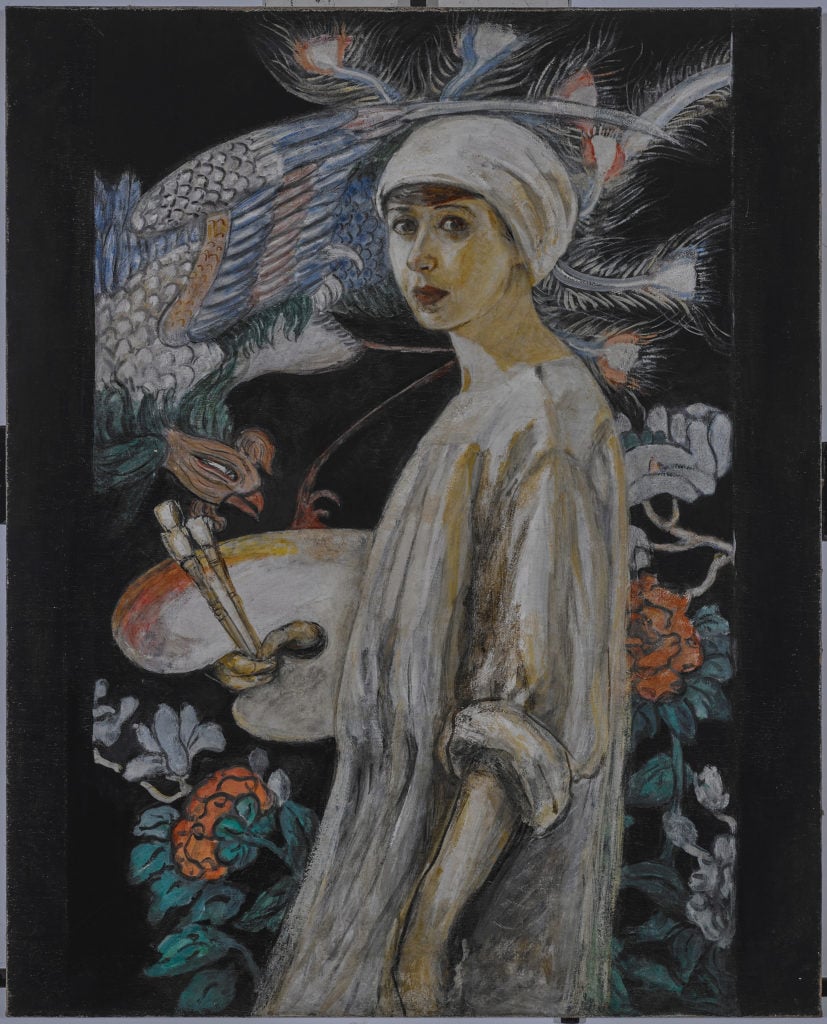
There are lots of reasons you've never heard of Florine Stettheimer—now, you have the chance to get to know her.

Sarah Cascone

Florine Stettheimer (1871–1944) may be the most important Modernist painter you’ve never heard of. A member of New York’s elite artistic circle between the First and Second World Wars, the painter and socialite made no effort to promote her work during her lifetime. She didn’t need the money, and she didn’t pursue fame.
Now, however, fame—or, at least, art historical prominence—is finding her anyway. A major exhibition of Stettheimer’s work at the Jewish Museum in New York has put her in the spotlight.
Several of the artist’s works were also included in the inaugural show at the Whitney Museum of American Art’s new meatpacking flagship in 2015, and last year in “O’Keeffe, Stettheimer, Torr, Zorach: Women Modernists in New York” at the Norton Museum of Art in Florida. In March, she was the centerpiece of Jeffrey Deitch’s booth at the Armory Show in New York.
But the Jewish Museum’s exhibition “Florine Stettheimer: Painting Poetry” (on view through September 24) is by far the most extensive look at Stettheimer’s career in recent years. The show presents her as central to American Modernism, but standing slightly apart from her peers thanks to her roots in Symbolism.
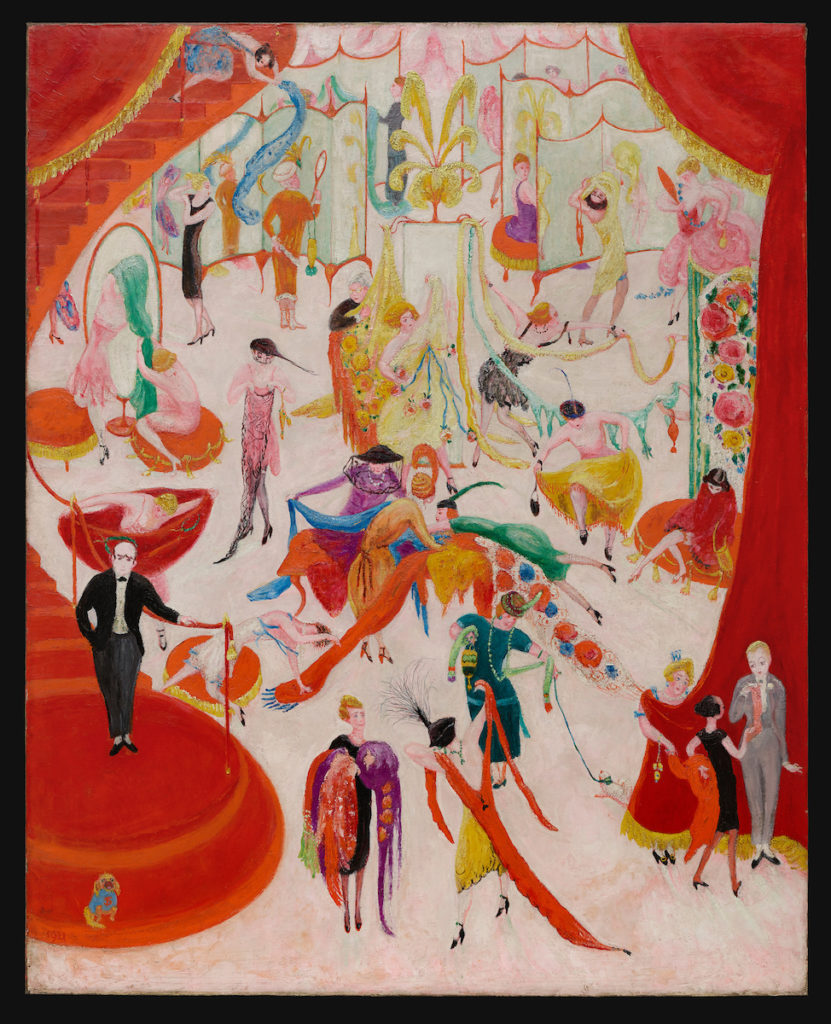
Florine Stettheimer, Spring Sale at Bendel’s (1921). Courtesy of the Philadelphia Museum of Art, gift of Miss Ettie Stettheimer.
While Stettheimer’s true significance to art history is now coming into focus, the market for her work is—and is likely to remain—fairly muted, thanks to her limited production and her sister’s dedication to getting her work into museum collections.
Only four of the 71 works in the Jewish Museum show come from private collections; the rest are on loan from institutions. And just six works by Stettheimer have ever been sold at auction, according to the artnet Price Database. The current record of $375,000 was set in January 2016 for Floral Still Life (1900), at Massachusetts’ Skinner Auctioneers.
“Her works have not really been subjected to a proper arithmetic,” Stephen Brown, the curator of the Jewish Museum’s show, tells artnet News. “I would estimate she probably made about 300 paintings in her lifetime.”
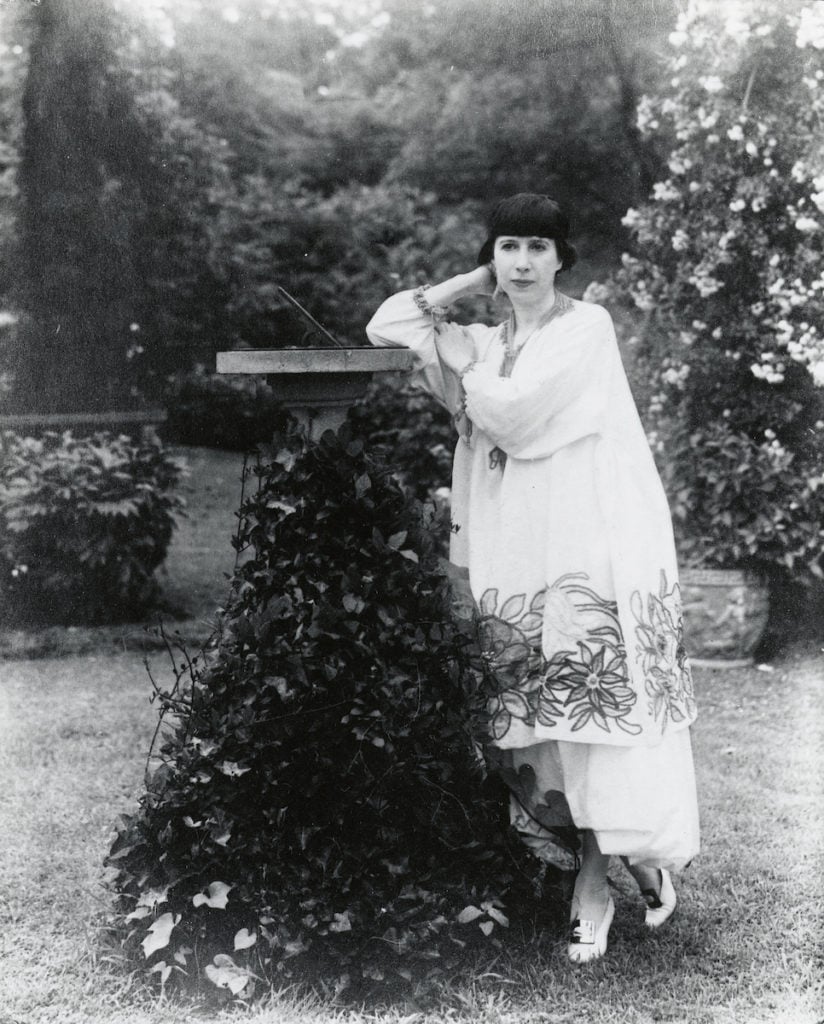
Peter A. Juley & Son, Florine Stettheimer (circa 1917–20). © Smithsonian American Art Museum.
Stettheimer’s long road to prominence is a testament to how slowly the canon accepts new members in the absence of news-making market developments, particularly when the artist in question is female and working in a style that does not align with the fashion of the day.
“The art market really makes history,” Brown says. “That exchange really creates the interest that drives the historical narrative.”
Making Art on Her Own Terms
Stettheimer’s minimal market presence can be traced back to her own disinterest in the art market. She had only one solo show during her lifetime, and it was, by all accounts, a major flop.
Held at New York’s Knoedler Gallery in 1916, the exhibition failed to sell a single work, and afterward Stettheimer opted to show her work only at her private salon and studio on Bryant Park. (She came from a wealthy banking family on both her parents’ sides, and was never wanting for money, even during the Great Depression.)
“It was probably mainly made up of floral pieces and still-lives,” says Brown of the Knoedler show, for which Stettheimer also made decorations in the gallery. “I think that very feminine setting with lace and flowers, in the middle of World War I, probably suggested to people that it wasn’t exactly of the moment… I think it could be seen as a kind of frivolity.” The fact that Stettheimer was a woman, and Jewish to boot, probably didn’t help endear her to potential collectors.
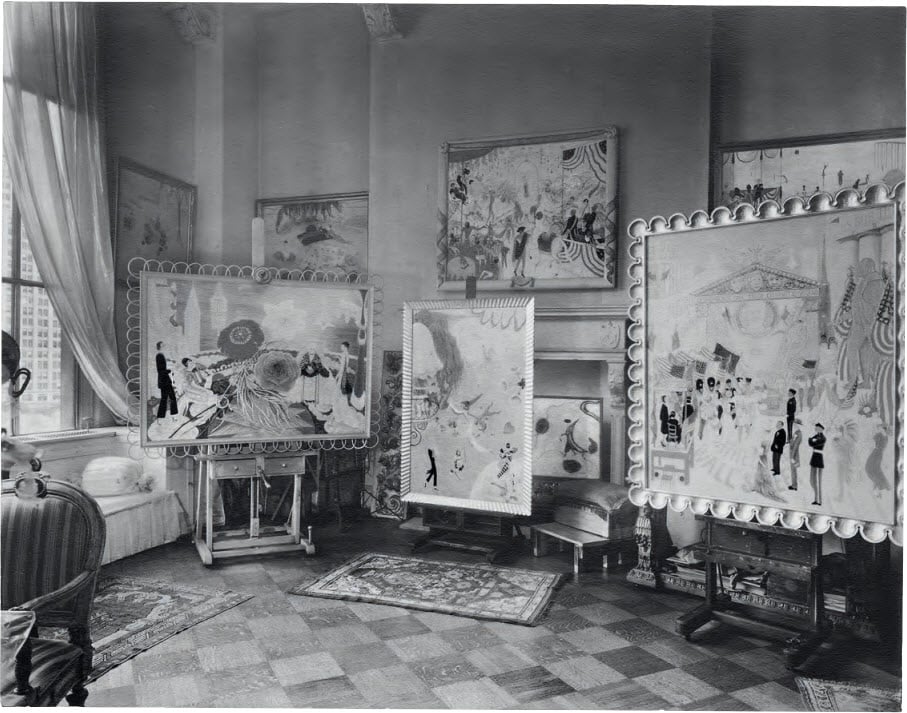
Florine Stettheimer’s studio at the Beaux-Arts Building, New York,
photograph by Peter A. Juley & Son (1944). Courtesy of the Florine Stettheimer Papers, Rare Book and Manuscript Library, Columbia University in the City of New York.
At home, however, her unique vision was appreciated by the upper crust of the art world. “She and her sisters held salons regularly with an impressive list of attendees including some of the most famous artistic and intellectual elite of the day,” Robin S.R. Starr, vice president of Boston’s Skinner Auctioneers, tells artnet News in an email.
Stettheimer’s friends, such as Francis Picabia and Marcel Duchamp, often urged her to give public exhibitions a second chance. Georgia O’Keeffe wrote Stettheimer a letter in 1929, saying “I wish you would become ordinary like the rest of us and show your paintings this year!” Alfred Stieglitz tried and failed to get her to show her work in December 1930, despite his offer that “you could add an Xmas tree if you wished.”
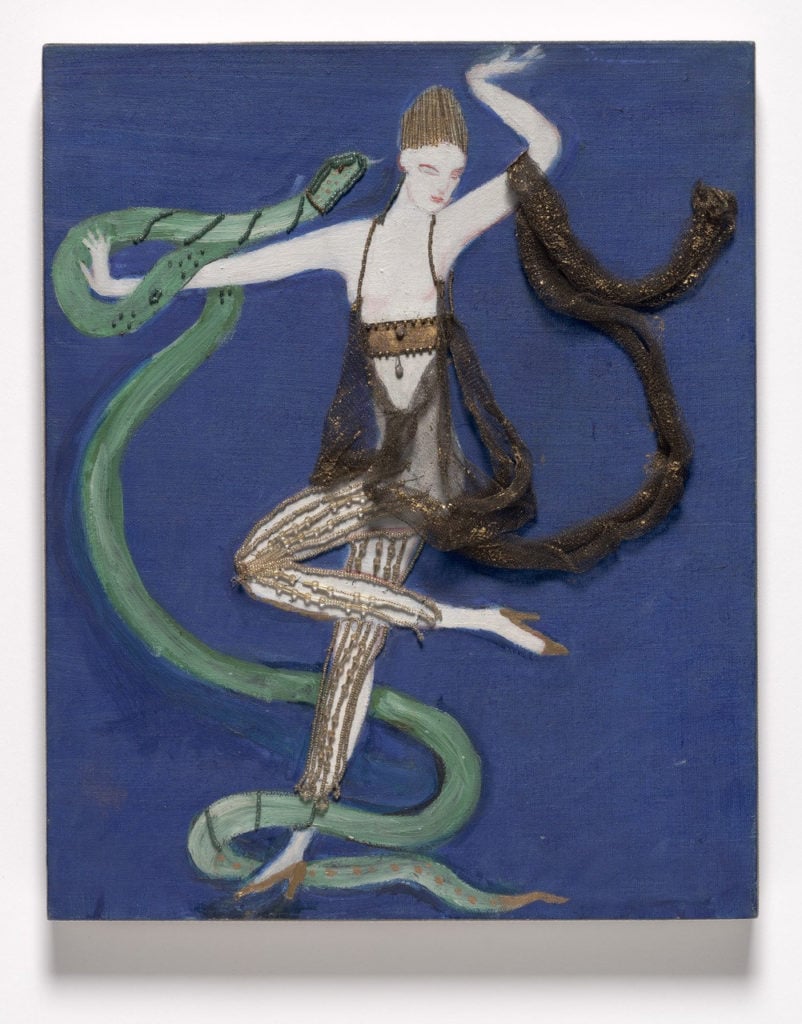
Florine Stettheimer, costume design (Euridice and the Snake) for the unrealized ballet Orphée of the Quat-z-arts (1912). Courtesy of Museum of Modern Art, New York, gift of Miss Ettie Stettheimer.
By choosing not to engage in such activity, Stettheimer freed herself from the constraints of public opinion—and from having to appeal to collectors. As a result, her work stood apart from the dominant movement of the era. “It was the time of Abstract Expressionism, and a concentrated attempt to create a new art in America,” Brown says. It would seem the macho, Abstraction-obsessed milieu couldn’t accommodate the work of an artist like Stettheimer.
Instead, “she became an artist’s artist, rather than having the extensive marketing of a Knoedlers or 291 or MacBeth or similar gallery that would have catapulted her work into the public eye,” says Starr. “Her work doesn’t fit in neatly with any particular niche.”
A Family Affair
Born in New York to a wealthy Jewish family and raised between the city and Europe, Stettheimer lived for most of her adult life with her mother and two sisters, Ettie and Carrie (the father abandoned the family).
Stettheimer’s sisters shared her creative impulses: Ettie wrote novels under the name Henrie Waste, and the dollhouse Carrie spent 20 years crafting today resides in the Museum of the City of New York. None of them ever married, and when they moved back to the States on the eve of World War I, they became hosts to New York’s avant-garde.
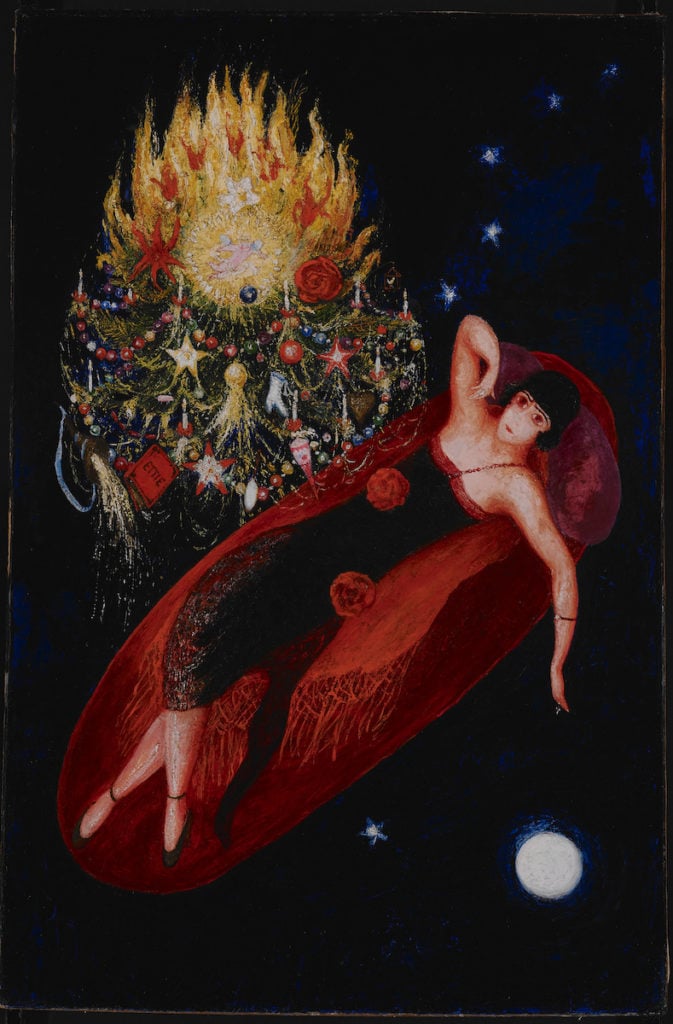
Florine Stettheimer, Portrait of My Sister, Ettie Stettheimer (1923). Courtesy of Columbia University Library, Gift of the Estate of Ettie Stettheimer, 1967.
First studying at New York’s Art Students League and later immersing herself in the European scene, Stettheimer absorbed the influences of Impressionism, Symbolism, Orientalism, and Viennese Art Nouveau. The Stettheimer women and their cultural milieu feature prominently in her dreamy, colorful, somewhat primitive-looking paintings, which depict a life of leisure and opulence.
A Place in the Canon
In her will, Stettheimer asked that all her work be destroyed upon her death. (She once wrote that “letting people have your paintings is like letting them wear your clothes.”) But her sister ignored her instructions and instead set about placing her work in major public collections.
“All the great museums were given the choice of the work from the collection,” says Brown. Two New York institutions boast particularly large Stettheimer holdings, thanks to generous gifts from Ettie: The Avery Architectural and Fine Arts Library at Columbia University, with 65 works, the largest collection anywhere; and the Museum of Modern Art (MoMA), with 56. (The Jewish Museum was not among the beneficiaries. “I wish we could fill that gap,” Brown laments.)
Two years after Stettheimer’s death, in 1946, Duchamp, who appears in several of her works, helped organize her first ever museum show, at MoMA.
Left Behind by the Market
By dispersing her sister’s work to high-profile institutions across the country, Ettie assured Stettheimer’s legacy. But she also left relatively few works to be sold on the market. (The few paintings that left Stettheimer’s possession during her lifetime were given as gifts to friends.)
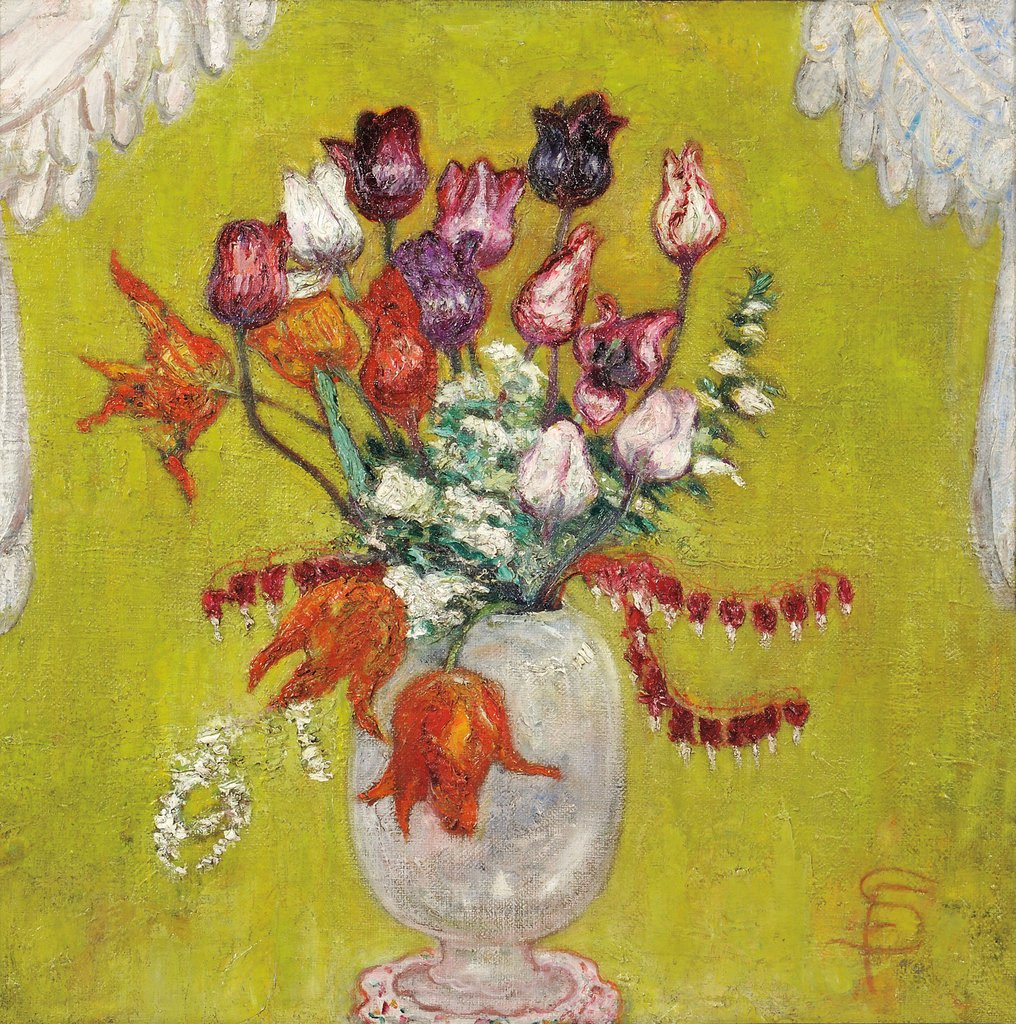
Florine Stettheimer, Floral Still Life (1900). The painting achieved a auction record for the artist, selling for $375,000 on an estimate of $75,000–100,000 at Skinner Auctioneers in Massachusetts.
There is no Stettheimer estate to be represented by a gallery, and very few of her works have ever been sold at auction. Prior to the record-setting sale of Floral Still Life (1900) in 2016, her work had been traded publicly just five times, all between 1990 and 1997, for prices ranging from $60,500 to $145,500. Every work except one—Stettheimer’s 1923 portrait of Marcel Duchamp and his female alter ego, Rrose Selavy, which sold at Sotheby’s in 1990 for $110,000, and is currently on view at the Jewish Museum—are floral paintings.
“Given her limited production, the lack of auction records is not surprising,” says Starr, noting that the current record-holder is the only Stettheimer painting that’s come to Skinner in her 30 years with the house.
“The still-life that we had was one of the strongest of her works to show at auction, but it is far from her most important work,” Starr adds. “No doubt the record for her work will increase dramatically should one of her greater works appear on the market.”
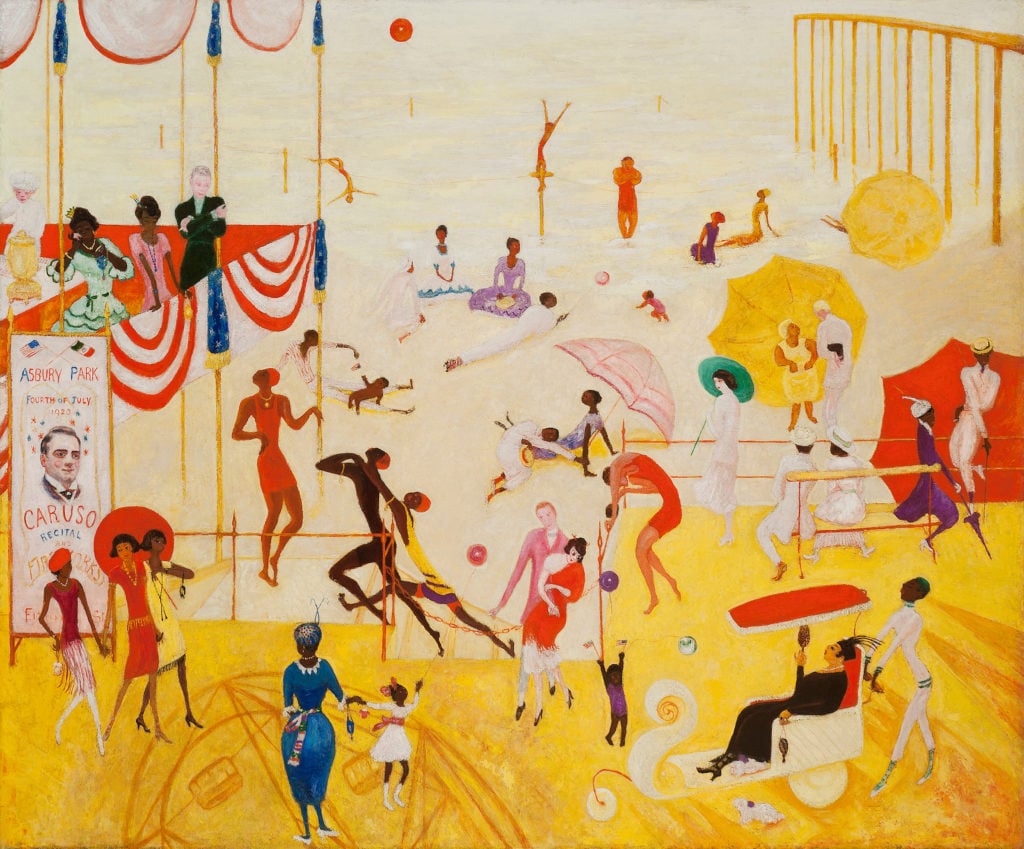
Florine Stettheimer, Asbury Park South (1920). Collection of Halley K. Harrisburg and Michael Rosenfeld, NY. Courtesy of Jewish Museum Press Office.
Indeed, when one major Stettheimer work, Asbury Park South (1920), was deaccessioned by Nashville’s financially struggling Fisk University in 2012, art dealer Francis Naumann estimated its value at $3 million. The work, a joyful, colorful celebration of the boardwalk on the Jersey Shore, was described by the the New York Times as the first major Stettheimer to come to market in 20 years. It was purchased in a private sale by the art dealer Michael Rosenfeld and his wife, Halley K. Harrisburg.
But save for these few public and semi-public sales, it remains difficult to get a full picture of the Stettheimer market, because there has not been a systematic overview of her oeuvre. Stettheimer has no catalogue raisonné, a full accounting of all her known works; without one, it is difficult to determine exactly how many still remain in private hands.
A Style All Her Own
The market also offers a distorted picture of Stettheimer’s oeuvre. After all, she did far more than floral paintings. Major works in the Jewish Museum show include Family Portrait II (1933), a whimsical composition featuring the Stettheimer women set against a backdrop of New York landmarks including the Statue of Liberty and Radio City Music Hall. Three gigantic flowers float in the middle of the composition.
One of her best early works, A Model (Nude Self-Portrait) (1915), a retread of Manet’s Olympia and Titian’s Venus of Urbino before it, is noteworthy due to its status as one of art history’s first nude self-portraits by a woman artist.
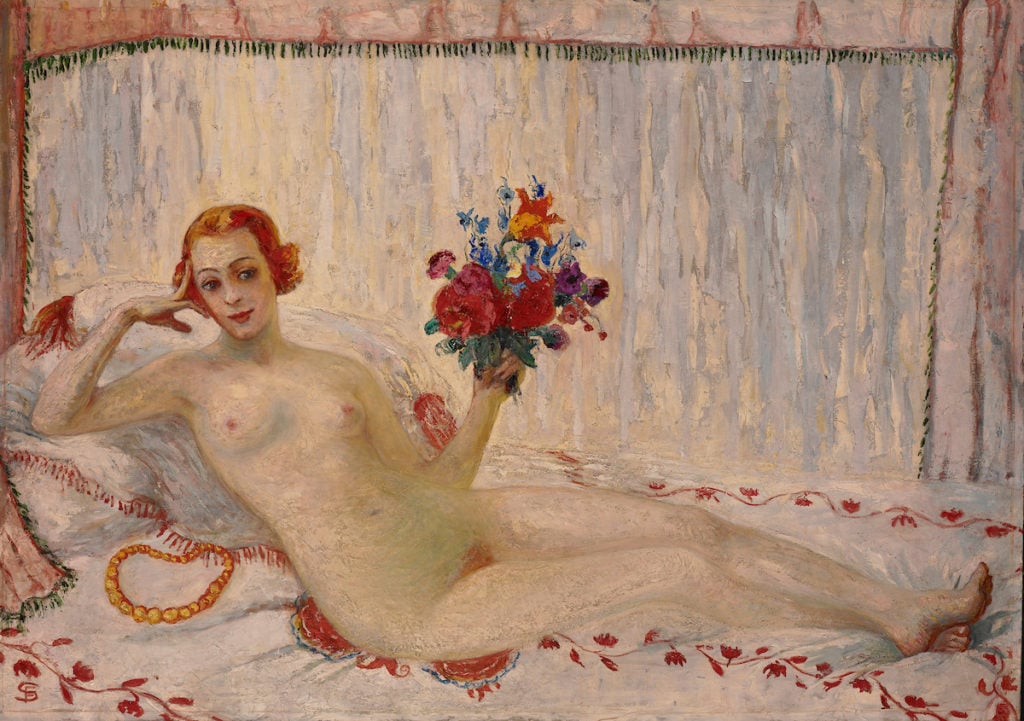
Florine Stettheimer, A Model (Nude Self-Portrait) (1915). Courtesy of Columbia University Library, Gift of the Estate of Ettie Stettheimer, 1967.
Another highlight is her ambitious costume and set designs for the unrealized ballet Orphée of the Quat-z-arts, rendered in gorgeous bricolage with fur, lace, beads, and oil paint in 1912. More than 20 years later, Stettheimer designed the sets and costumes for Virgil Tomson’s historic all-black black opera Four Saints in Three Acts, with a libretto by Gertrude Stein, which debuted on Broadway in 1934.
Cyclical Discovery
While Stettheimer has not yet become a bona-fide household name, she has continued to hold cult status as an artist’s artist. At this year’s Armory Show, New York’s recently reopened Deitch Projects reprised a Stettheimer-inspired booth the dealer first staged in 1995, when the Armory was known as the Gramercy International Art Fair.
Titled “The Florine Stettheimer Collapsed Time Salon,” Deitch’s booth featured bright pink walls and iridescent cellophane curtains—a staple at Stettheimer’s salon and part of her Four Saints set. The centerpiece of the stand was Stettheimer’s Asbury Park South. The painting, which was the only Stettheimer on display and not for sale, also appears in the Jewish Museum show.
Deitch’s reprised display is a reminder that this is not the first time Stettheimer seemed poised to claim her rightful place in the canon. In her review of the Jewish Museum show for the New York Times, Roberta Smith notes that “every 20 years or so, an exhibition devoted to Florine Stettheimer… shakes up modernism’s orderly hierarchies.”
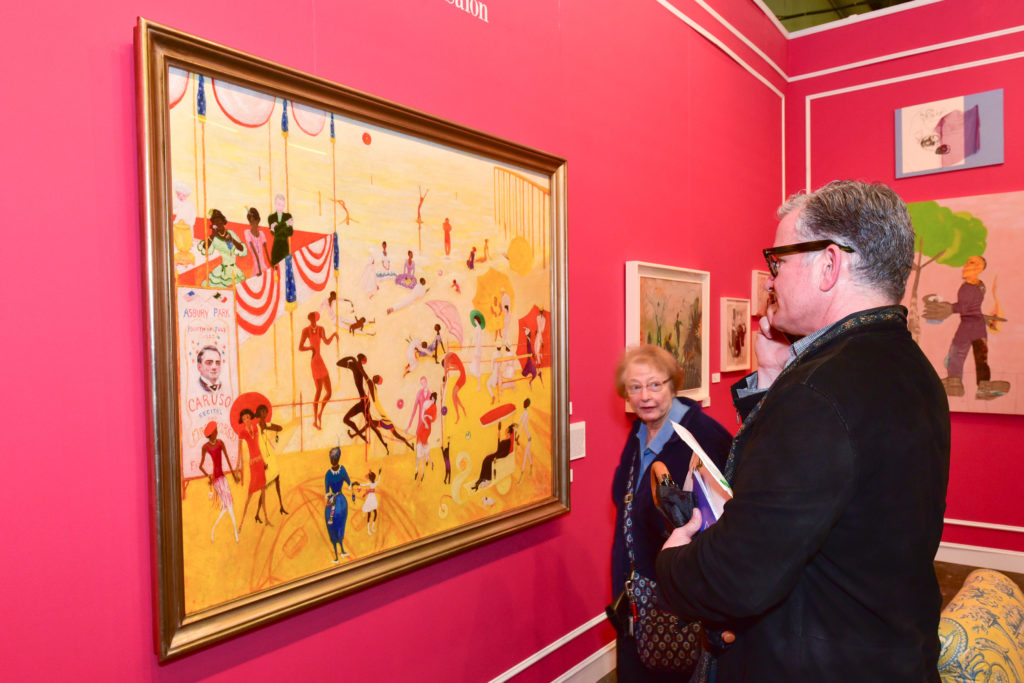
Florine Stettheimer, Asbury Park South (1920) at Jeffrey Deitch’s 2017
Armory Show booth, titled “The Florine Stettheimer Collapsed Time Salon.” Courtesy Sean Zanni, © Patrick McMullan.
The original 1995 “Collapsed Time Salon” booth coincided with the exhibition “Florine Stettheimer: Manhattan Fantastica” at New York’s Whitney Museum that same year. At that time, Smith wrote that “posterity is ready now” to recognize Stettheimer’s contributions.
But, it seems, posterity was not quite ready after all. The Jewish Museum exhibition is Stettheimer’s first solo show in North America in the over two decades. In fact, since her MoMA debut, the artist’s exhibitions have been few and far between: ICA Boston in 1980, at New York’s Katonah Museum of Art in 1993, the Whitney, and most recently at the Lenbachhaus in Munich in the fall of 2014. Maybe after all this time, posterity has finally arrived for good.
“Florine Stettheimer: Painting Poetry” is on view at the Jewish Museum, 1109 5th Ave at East 92nd Street, May 5–September 24.